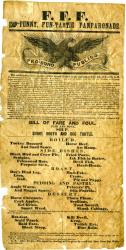The second decade of the 19th century kicked off a period of immense change for Biddeford and Saco. In 1820 Maine became a state in its own right, no longer a district of the Commonwealth of Massachusetts. There was still a good deal of agricultural activity going on in the area, but new industries taking advantage of the river and the sea were starting or expanding.

Odd Fellows Poster/Broadside, Biddeford, ca. 1855
McArthur Public Library
The Perkins shipyard opened in the 1820s, and by the 1840's it would be one of the most important shipyards in the state. In 1825 the Saco Manufacturing Company and the Saco Iron Works opened on Cutts Island in Saco; the precursor to the industrialization which would be the making of the towns on either side of the river. The first Saco venture was not successful, and eventually burned down, but was followed by the incredibly successful York Manufacturing Company, whose main owner was Charles Bradbury of Boston. He hired Samuel Batchelder, who made the mill a success. Both men had hands in the Saco Water Power Company as well, the real estate and machinery arm of the venture. These men & their companies would start and operate the Laconia and finally Pepperell Manufacturing Companies on the Biddeford side of the river as well.

Mark Gould report card, Biddeford, 1854-55
McArthur Public Library
The 1840s and 50s were full of firsts for Biddeford: the opening of the steam railroad (only 5 hours to Boston!), the first "block" built, the first bank, the first fire company, first fraternal lodge, first high school, first newspaper, first city directory, first textile mills and the first French-Canadian immigrant. In 1855 this growth manifested itself in Biddeford's transition from town to city. Biddeford's first mayor was Daniel Eton Somes, a developer and businessman who built the Somesville neighborhood in Saco and the Somes Block on Main Street in Biddeford. He would be elected to Congress in 1868 and spend the rest of his life in Washington, D.C.
When war broke out between the states in 1861, the first company of Biddeford volunteers left that May. By October of the next year more than half of all able-bodied men were in the armed services, and at the end of the war 1,000 men had gone off to fight. The war years in the city were difficult; high taxes, city debt, mill layoffs & the ensuing joblessness and poverty took their toll.